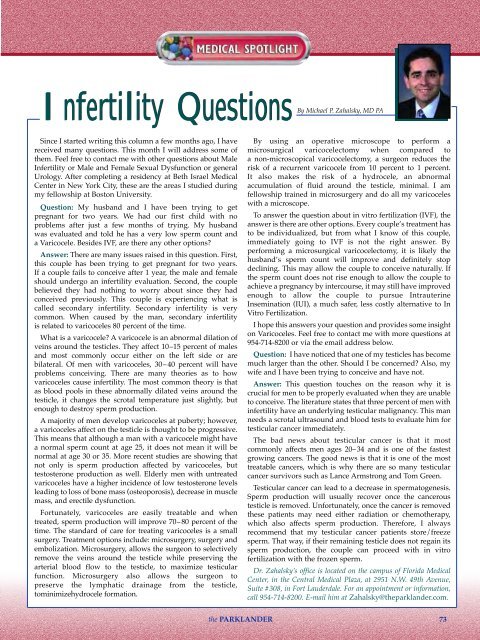June 2006 - The Parklander Magazine
June 2006 - The Parklander Magazine
June 2006 - The Parklander Magazine
- No tags were found...
Create successful ePaper yourself
Turn your PDF publications into a flip-book with our unique Google optimized e-Paper software.
Infertility QuestionsInfertility QuestionsBy Michael P. Zahalsky, MD PASince I started writing this column a few months ago, I havereceived many questions. This month I will address some ofthem. Feel free to contact me with other questions about MaleInfertility or Male and Female Sexual Dysfunction or generalUrology. After completing a residency at Beth Israel MedicalCenter in New York City, these are the areas I studied duringmy fellowship at Boston University.Question: My husband and I have been trying to getpregnant for two years. We had our first child with noproblems after just a few months of trying. My husbandwas evaluated and told he has a very low sperm count anda Varicocele. Besides IVF, are there any other options?Answer: <strong>The</strong>re are many issues raised in this question. First,this couple has been trying to get pregnant for two years.If a couple fails to conceive after 1 year, the male and femaleshould undergo an infertility evaluation. Second, the couplebelieved they had nothing to worry about since they hadconceived previously. This couple is experiencing what iscalled secondary infertility. Secondary infertility is verycommon. When caused by the man, secondary infertilityis related to varicoceles 80 percent of the time.What is a varicocele? A varicocele is an abnormal dilation ofveins around the testicles. <strong>The</strong>y affect 10–15 percent of malesand most commonly occur either on the left side or arebilateral. Of men with varicoceles, 30– 40 percent will haveproblems conceiving. <strong>The</strong>re are many theories as to howvaricoceles cause infertility. <strong>The</strong> most common theory is thatas blood pools in these abnormally dilated veins around thetesticle, it changes the scrotal temperature just slightly, butenough to destroy sperm production.A majority of men develop varicoceles at puberty; however,a varicoceles affect on the testicle is thought to be progressive.This means that although a man with a varicocele might havea normal sperm count at age 25, it does not mean it will benormal at age 30 or 35. More recent studies are showing thatnot only is sperm production affected by varicoceles, buttestosterone production as well. Elderly men with untreatedvaricoceles have a higher incidence of low testosterone levelsleading to loss of bone mass (osteoporosis), decrease in musclemass, and erectile dysfunction.Fortunately, varicoceles are easily treatable and whentreated, sperm production will improve 70– 80 percent of thetime. <strong>The</strong> standard of care for treating varicoceles is a smallsurgery. Treatment options include: microsurgery, surgery andembolization. Microsurgery, allows the surgeon to selectivelyremove the veins around the testicle while preserving thearterial blood flow to the testicle, to maximize testicularfunction. Microsurgery also allows the surgeon topreserve the lymphatic drainage from the testicle,tominimizehydrocele formation.By using an operative microscope to perform amicrosurgical varicocelectomy when compared toa non-microscopical varicocelectomy, a surgeon reduces therisk of a recurrent varicocele from 10 percent to 1 percent.It also makes the risk of a hydrocele, an abnormalaccumulation of fluid around the testicle, minimal. I amfellowship trained in microsurgery and do all my varicoceleswith a microscope.To answer the question about in vitro fertilization (IVF), theanswer is there are other options. Every couple’s treatment hasto be individualized, but from what I know of this couple,immediately going to IVF is not the right answer. Byperforming a microsurgical varicocelectomy, it is likely thehusband’s sperm count will improve and definitely stopdeclining. This may allow the couple to conceive naturally. Ifthe sperm count does not rise enough to allow the couple toachieve a pregnancy by intercourse, it may still have improvedenough to allow the couple to pursue IntrauterineInsemination (IUI), a much safer, less costly alternative to InVitro Fertilization.I hope this answers your question and provides some insighton Varicoceles. Feel free to contact me with more questions at954-714-8200 or via the email address below.Question: I have noticed that one of my testicles has becomemuch larger than the other. Should I be concerned? Also, mywife and I have been trying to conceive and have not.Answer: This question touches on the reason why it iscrucial for men to be properly evaluated when they are unableto conceive. <strong>The</strong> literature states that three percent of men withinfertility have an underlying testicular malignancy. This manneeds a scrotal ultrasound and blood tests to evaluate him fortesticular cancer immediately.<strong>The</strong> bad news about testicular cancer is that it mostcommonly affects men ages 20– 34 and is one of the fastestgrowing cancers. <strong>The</strong> good news is that it is one of the mosttreatable cancers, which is why there are so many testicularcancer survivors such as Lance Armstrong and Tom Green.Testicular cancer can lead to a decrease in spermatogenesis.Sperm production will usually recover once the canceroustesticle is removed. Unfortunately, once the cancer is removedthese patients may need either radiation or chemotherapy,which also affects sperm production. <strong>The</strong>refore, I alwaysrecommend that my testicular cancer patients store/freezesperm. That way, if their remaining testicle does not regain itssperm production, the couple can proceed with in vitrofertilization with the frozen sperm.Dr. Zahalsky’s office is located on the campus of Florida MedicalCenter, in the Central Medical Plaza, at 2951 N.W. 49th Avenue,Suite #308, in Fort Lauderdale. For an appointment or information,call 954-714-8200. E-mail him at Zahalsky@theparklander.com.the PARKLANDER73
















